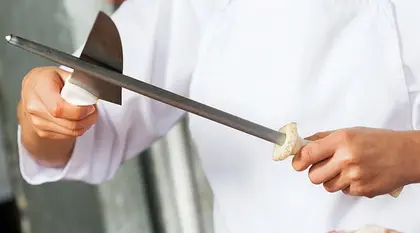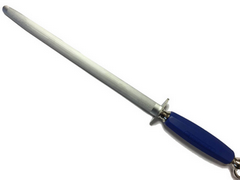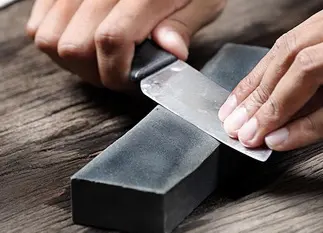This site uses only a few technical cookies necessary for its operation. By continuing to browse, you accept their use.
To find out more...
To find out more...
In praise of the whetstone

Have you ever seen a butcher or a chef sharpen his knife before using it?
Usually he uses a special tool, a long thin cylinder made of very hard metal.
And in a smooth and elegant gesture, he very quickly passes the edge of the knife against the rifle, which makes a very characteristic noise, and in a few seconds the knife is again well sharpened, ready to slice.
I am very impressed by this sharpening gesture which seems very simple, but is not at all, there is a question of blade angle, direction, and intensity of pressure to obtain a nice edge or thread on the knife, and not to crush it completely.
Usually he uses a special tool, a long thin cylinder made of very hard metal.
And in a smooth and elegant gesture, he very quickly passes the edge of the knife against the rifle, which makes a very characteristic noise, and in a few seconds the knife is again well sharpened, ready to slice.
I am very impressed by this sharpening gesture which seems very simple, but is not at all, there is a question of blade angle, direction, and intensity of pressure to obtain a nice edge or thread on the knife, and not to crush it completely.
12 K 4.8/5 (17 reviews)
Last modified on: June 5th 2021
In praise of the whetstone
So I always envied it, but I almost never got it right, and yet my son who is in the business showed me several times "Look dad, it's easy, you put the tool like this, the knife like this and go!
But nothing to do, I can't sharpen a knife properly with a that...
And yet I have, like you perhaps, a good set of knives at home, and since there is nothing more painful than a knife that cuts badly when you cook (a knife "just good for ruining your appetite" say the cooks), as soon as the need was felt I called a sharpener. He sharpens well, he uses a grinding wheel, but each time I have to go and come back, not easy.
So I was overdoing it when it came to sharpening, until I finally switched to the sharpening stone.
If you're not familiar with it, it's very simple: it's a stone (some of them natural) with a fairly long rectangular shape, which you simply wet generously before passing it gently flat over the knife blade, from the thick side towards the edge.
That's all there is to it! No need for any particular skill, the gesture is very simple, I can do it by myself that's to say, and above all very efficient: the stone, very fine in texture, polishes the blade in a way, and as you work flat, no or few risks of dodging the edge.
You just have to re-wet the stone from time to time and rinse the blade to eliminate the stone and metal dust that forms.
All this to say that if you have difficulties sharpening your knives, the sharpening stone may be the solution you need.
If you are thinking of buying one, you will find artificial ones, which are made in Asia from silica powder, very very cheap, but not much better than that.
And if not, for a much better quality, did you know that we have in the Pyrenees the last whetstone factory in Europe, which extracts from a local quarry and shapes natural whetstones of exceptional quality?
Well I admit that before I saw it in a "Faut pas rêver" topic, I had never heard of it! But they're out there, making great stones, not very expensive, that will last you at least a lifetime.
See their site, they have dealers in quite a few corners, I bought mine here, and before you kid me on that, no I don't have any stock or percentage with them :-).
Note that the stone comes with a little instruction manual, very pictorial and very well done.
In summary: Not comfortable with a tool to sharpen your knives? Try the whetstone, and in this case let yourself be tempted by a beautiful natural stone from the Pyrenees.

But nothing to do, I can't sharpen a knife properly with a that...
And yet I have, like you perhaps, a good set of knives at home, and since there is nothing more painful than a knife that cuts badly when you cook (a knife "just good for ruining your appetite" say the cooks), as soon as the need was felt I called a sharpener. He sharpens well, he uses a grinding wheel, but each time I have to go and come back, not easy.
So I was overdoing it when it came to sharpening, until I finally switched to the sharpening stone.
If you're not familiar with it, it's very simple: it's a stone (some of them natural) with a fairly long rectangular shape, which you simply wet generously before passing it gently flat over the knife blade, from the thick side towards the edge.

That's all there is to it! No need for any particular skill, the gesture is very simple, I can do it by myself that's to say, and above all very efficient: the stone, very fine in texture, polishes the blade in a way, and as you work flat, no or few risks of dodging the edge.
You just have to re-wet the stone from time to time and rinse the blade to eliminate the stone and metal dust that forms.
All this to say that if you have difficulties sharpening your knives, the sharpening stone may be the solution you need.
If you are thinking of buying one, you will find artificial ones, which are made in Asia from silica powder, very very cheap, but not much better than that.
And if not, for a much better quality, did you know that we have in the Pyrenees the last whetstone factory in Europe, which extracts from a local quarry and shapes natural whetstones of exceptional quality?

Well I admit that before I saw it in a "Faut pas rêver" topic, I had never heard of it! But they're out there, making great stones, not very expensive, that will last you at least a lifetime.

See their site, they have dealers in quite a few corners, I bought mine here, and before you kid me on that, no I don't have any stock or percentage with them :-).
Note that the stone comes with a little instruction manual, very pictorial and very well done.
In summary: Not comfortable with a tool to sharpen your knives? Try the whetstone, and in this case let yourself be tempted by a beautiful natural stone from the Pyrenees.
Lasts posts
Butter vs. grease
We often read in a recipe where a pastry is put into a mould that, just before pouring, the mould should be buttered or greased. But what's the difference between these 2 terms?December 1st 20258285
Getting out of the fridge early
Very often when you're cooking, you need to take food or preparations out of the fridge, to use them in the recipe in progress. There's nothing tricky about this: you just take them out of the fridge and use them, usually immediately, in the recipe. But is this really a good method?November 24th 20251,0265
Who's making the croissants?
When you look at a bakery from the outside, you naturally think that in the bakery, the bakers make the bread, and in the laboratory, the pastry chefs make the cakes. It's very often like that, with each of these professions having quite different ways of working, but sometimes there's also one...November 23th 2025926
Oven height
When we put a dish or cake in the oven, we naturally tend to put it on the middle shelf, and that's what we usually do. But in some cases, this position and height can be a little tricky, so let's find out why.October 8th 20252,5595
The importance of sieving
In recipes that use a fine powder (flour, powdered sugar, etc.), you'll often see the advice to sift before using it. To sift is to pass the powder in question through a sieve (a very fine strainer) before incorporating it into your recipe. It's often advice, but is it really useful?September 3rd 20257,4183
Other pages you may also like
Small, regular pieces
When we cook, bake or pastry, we often have to cut food into small pieces, often cubes, to incorporate them into a recipe or preparation. How do you get regular pieces fairly quickly?November 28th 202011 K4.5
Foie gras service
For the upcoming christmas meals you too may be sacrificing to the tradition of foie gras? If so, I suggest you take a look at everything that revolves around serving foie gras: how to serve it, and what to eat and drink with it.December 23th 201716 K4.9
Let's rehabilitate the burger
The burger is a sandwich that is very fashionable at the moment, and as for all other sandwiches, the worst (often) rubs shoulders with the best (much more rare). In principle, I'm probably not teaching you anything, it's a sandwich made of a small round bun, rather soft, like a sandwich bread,...April 10th 20219,7474.9
Beans in primeur
As I write this, it is the beginning of the short season for fresh beans. If you've never made them before and you're just starting out (and that's a great idea) you'll find that it's a bit time consuming to prepare, you have to shell them once, remove the beans, scald them to remove the skin (and...June 4th 202214 K
How to zest a fruit?
You will have no doubt noticed that many recipes call for the zest of citrus fruit. The zest is that outer layer of the skin which adds so much flavour to a dish. There are many different ways to peel off the zest and various tools are available. Here is a summary of the “dos and don'ts” of...November 5th 201347 K3.8
Post a comment or question
Follow this page
If you are interested in this page, you can "follow" it, by entering your email address here. You will then receive a notification immediately each time the page is modified or a new comment is added. Please note that you will need to confirm this following.
Note: We'll never share your e-mail address with anyone else.
Alternatively: you can subscribe to the mailing list of cooling-ez.com , you will receive a e-mail for each new recipe published on the site.









